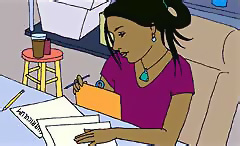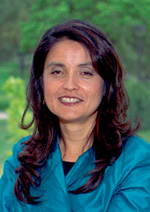What should Ms. Begay find out about her students before planning her curriculum units and lessons?
Page 6: Gather Information
 Gathering information about each student is necessary for curricular decision-making. To do this, Ms. Begay needs to determine the level at which her students are functioning in the general education curriculum and which standards they have and have not met. She also has to figure out her students’ individual learning characteristics. Some of these are:
Gathering information about each student is necessary for curricular decision-making. To do this, Ms. Begay needs to determine the level at which her students are functioning in the general education curriculum and which standards they have and have not met. She also has to figure out her students’ individual learning characteristics. Some of these are:
- Background knowledge and experience
- Learning preferences (i.e., visual, auditory, kinesthetic, tactile)
- Academic strengths
- Academic improvement areas
- Responsiveness to instruction and correction
- Social and interpersonal behaviors
- Interests
- Talents
- Home language and any second language issues
- Cultural, community, and religious factors
Listen to Diane Torres-Velásquez as she discusses ways to learn about a student’s language background (time: 1:45).

Diane Torres-Velásquez, PhD
Associate Professor, Special Education Department
University of New Mexico
Transcript: Diane Torres-Velásquez, PhD
I worked with this teacher, Gilberto Lobo at Truman Middle School, and in that article I presented one of the things that he does. And one of the things he does I think is really smart is at the very beginning of the school year, he takes, he collects data with the students about themselves. And that’s a very mathematical activity, but that’s also a political activity and cultural activity and that’s because he then uses that information in his relationships with the parents and he uses it in a constructive way. But he has just a couple of questions that he gives the students and then he collects data on those questions. They develop a graph and then they use that graph to not only learn about graphs but to learn about each other. So the questions that he asks are “What language do you speak at home?” and “What country did your family come from?” and then “What language do your parents speak?” And so, by asking that question, then he gets a lot of information about the proficiency levels of the family so that he knows what language he can send information home in. But he also gets a lot of information about where these students are from as far as their country so that they can then look at social studies and look at the globe and connect math to where they come from, how many miles they traveled, how long they’ve been here, and then they graph this information. So then he teaches them about graphing skills. And so, for example, in this case he’ll start by collecting the data, and then he’ll have the students observe what it is that they are seeing in the data and describe it and make sense of what they’re seeing in this abstract representation of a graph.
By developing these profiles of her students, Ms. Begay makes a number of curricular and instructional decisions that can make or break student performance. Additional considerations include:
- Reading level(s) of materials
- Topics, concepts, and skills of relevance or interest
- Concepts in relation to those of students’ own cultures
- Opportunity for individual, small group, and large group instruction
- Opportunity for students and families to contribute to the classroom experiences
- How instructional material is presented
Activity
Think about one or two struggling students. Brainstorm how you would learn about their backgrounds, academic skills, and strengths and weaknesses. Identify who could help you to gather this information and how the information might inform your lesson plan.